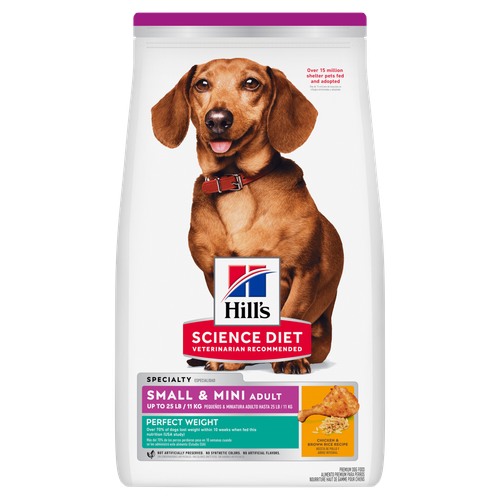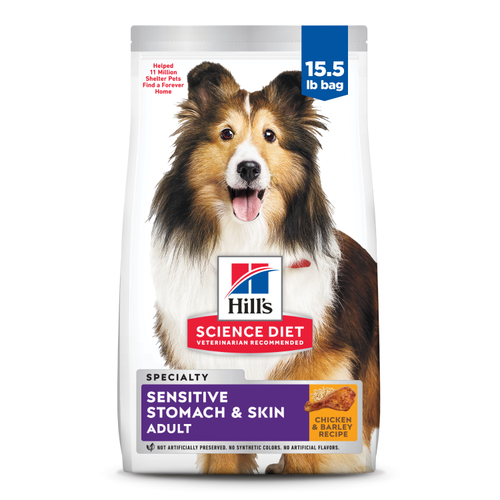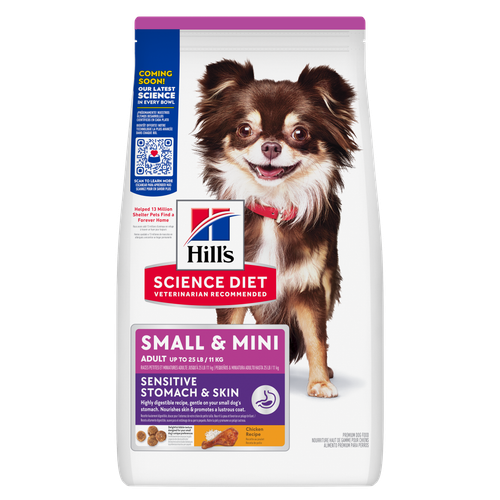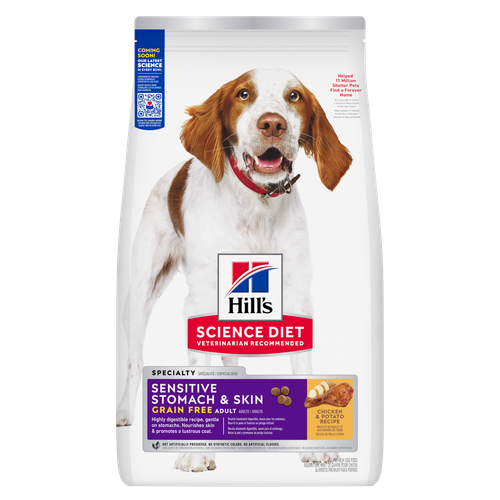
-
Find the right food for your petTake this quiz to see which food may be the best for your furry friend.Find the right food for your petTake this quiz to see which food may be the best for your furry friend.Featured products
 Adult Chicken & Barley Recipe Dog Food
Adult Chicken & Barley Recipe Dog FoodSupports lean muscle and beautiful coat for adult dogs
Shop Now Hill's Science Diet Adult Chicken & Beef Entrée Dog Food
Hill's Science Diet Adult Chicken & Beef Entrée Dog FoodChicken & Beef Entrée in a delicious loaf with complete & balanced nutrition to help keep adult dogs active and healthy
Shop Now Adult Large Breed Chicken & Barley Recipe Dog Food
Adult Large Breed Chicken & Barley Recipe Dog FoodSupports healthy joints, lean muscle, and beautiful coat for large breed dogs
Shop NowFeatured products Senior Vitality Adult 7+ Tuna & Vegetables Stew
Senior Vitality Adult 7+ Tuna & Vegetables StewImproves Everyday Ability to Get Up & Go
Shop Now Adult Tender No Corn, Wheat, Soy Chicken & Vegetables Stew Cat FoodShop Now
Adult Tender No Corn, Wheat, Soy Chicken & Vegetables Stew Cat FoodShop Now Adult Turkey & Liver Entrée Cat Food
Adult Turkey & Liver Entrée Cat FoodPrecisely balanced nutrition with the delicious taste of minced turkey & liver to help fuel the energy needs of cats during the prime of their life
Shop Now -
Dog
- Dog Tips & Articles
-
Health Category
- Weight
- Food & Environmental Sensitivities
- Urinary
- Digestive
- Joint
- Kidney
-
Life Stage
- Puppy Nutrition
- Adult Nutrition
- Senior Nutrition
Cat- Cat Tips & Articles
-
Health Category
- Weight
- Skin & Food Sensitivities
- Urinary
- Digestive
- Kidney
-
Life Stage
- Kitten Nutrition
- Adult Nutrition
Featured articles How to Properly Mix Wet & Dry Pet Foods
How to Properly Mix Wet & Dry Pet FoodsAn Orange cat eating from a bowl filled with mixed food
Read More What Is Littermate Syndrome? Pet Adoption Guide
What Is Littermate Syndrome? Pet Adoption GuideLearn more about littermate syndrome in dogs and cats and how to successfully navigate adoption and early socialization processes.
Read More The Science Behind Our Love for Pets
The Science Behind Our Love for PetsLearn the scientific reasons why we have such strong connections with our pets, and what science says about the love between humans and our furry friends.
Read More -


Burrs on dogs are a problem few dog parents manage to avoid. And when those spiky seeds get stuck in your dog's fur after a hike through the woods or a romp in the tall grass, they can be difficult to remove. Read on to learn all about this sticky issue and discover how to remove burrs from dog fur safely and effectively.
Can Burrs Harm My Dog?
 Burrs, also known as burdock, cockleburs or sticktights, describe any number of plant seeds enclosed in a spiky or sticky outer shell. These tend to cling to a dog's fur whenever they brush up against them. Burrs clinging to the outer surface of a dog's coat don't typically cause discomfort. However, burrs can work their way deeper into the fur and become embedded in the skin, which is not only painful, but it can also become infected if not removed, noted Cuteness. Burrs can also get painfully stuck in your pup's paws and embedded between the toes. Therefore, it's important to check your dog thoroughly, from nose to tail to toes, anytime they've spent time out in nature and promptly remove any burrs you find. Don't leave them, hoping they'll fall out on their own.
Burrs, also known as burdock, cockleburs or sticktights, describe any number of plant seeds enclosed in a spiky or sticky outer shell. These tend to cling to a dog's fur whenever they brush up against them. Burrs clinging to the outer surface of a dog's coat don't typically cause discomfort. However, burrs can work their way deeper into the fur and become embedded in the skin, which is not only painful, but it can also become infected if not removed, noted Cuteness. Burrs can also get painfully stuck in your pup's paws and embedded between the toes. Therefore, it's important to check your dog thoroughly, from nose to tail to toes, anytime they've spent time out in nature and promptly remove any burrs you find. Don't leave them, hoping they'll fall out on their own.
How to Remove Burrs From Dog Fur
Burr removal typically happens in two or three phases, each of which requires time and patience, explained Daily Puppy.
- Phase 1: Start by picking off the easiest burrs with your fingers — you might want to wear gloves to protect your skin from getting stuck. Next, use a metal or wire comb and run it through your dog's fur while holding down the base of each section you're combing to prevent pulling. Be sure to offer your dog a ton of praise and a treat or two to help them stay patient with this process.
- Phase 2: For burrs that have become severely entangled in your dog's coat, work slowly, gently pulling your dog's matted fur away from the burr with your fingers or the end of your comb. It might help to apply a little conditioner or some coconut or vegetable oil to the matted area and the burr to help loosen it. Trending Breeds also recommends using pliers to crush the burr into smaller pieces, being careful not to pinch your dog's skin in the process. If you use a lubricating substance on your dog, be sure to bathe them once all the burrs are removed.
- Phase 3: Sometimes it's necessary to call in reinforcements. If you simply can't remove all of the burrs on your own, or if your dog won't sit still and let you remove them, a professional groomer might have an easier time de-burring your dog. And, if you find any embedded in your dog's skin, it would be best to let your veterinarian do the removing, especially if you notice signs of infection such as redness or oozing.


Tasty Tips
Preventing Burrs on Dogs
While the only surefire way to prevent your pooch from getting burrs is to keep them indoors, there are a few things you can do to help avoid them, or at least reduce their number.
Stick to sidewalks and cultivated areas, and avoid walking your pup or letting them go off-leash in areas with a lot of wild plant growth.
Put a jacket or vest on your dog to reduce the amount of fur that could come in contact with burrs. If your dog can tolerate them, booties can also protect their paw pads from getting stuck.
Keep your yard mowed to prevent grass and weeds from getting tall enough to produce burrs.
If hiking with your dog, remove burrs as soon as you notice them clinging to your dog — don't wait until the end of your adventure, giving them a chance to pile up.
Burrs are usually more of an annoying problem than a serious one. But, if ignored, they can turn serious. The faster you act to deal with them, the better it will be for your dog.


Jean Marie Bauhaus is a pet parent, pet blogger, and novelist from Tulsa, Oklahoma, where she usually writes under the supervision of a lapful of fur babies.
Related products

Over 70% of dogs lost weight within 10 weeks when fed this nutrition (USA Study)

Highly digestible recipe, gentle on stomachs. Nourishes skin & promotes a lustrous coat

Hill's Science Diet Sensitive Stomach & Skin Small & Mini dry dog food is tailored nutrition for Small & Mini dogs while being gentle on stomachs. Nourishes skin & promotes a lustrous coat.

Hill's Science Diet Sensitive Stomach & Skin Grain Free dry dog food is gentle on stomachs. Nourishes skin & promotes a lustrous coat.
Related articles

Wondering where can I buy a dog? Consider adoption and explore the pros and cons of adopting a dog from a breeder versus an animal shelter.

Learn how to help keep your dog's immune system in tip-top shape, including nutritional immune system support for dogs and other strategies.

Discover how the field of dog science is giving us more and more insights into the inner workings of our furry best friends.

Your dog's coat and skin are a big part of your dog's overall health. Ensure you keep your dog's coat healthy, by following these simple tips.

Put your dog on a diet without them knowing
Our low calorie formula helps you control your dog's weight. It's packed with high-quality protein for building lean muscles, and made with purposeful ingredients for a flavorful, nutritious meal. Clinically proven antioxidants, Vitamin C+E, help promote a healthy immune system.
Put your dog on a diet without them knowing
Our low calorie formula helps you control your dog's weight. It's packed with high-quality protein for building lean muscles, and made with purposeful ingredients for a flavorful, nutritious meal. Clinically proven antioxidants, Vitamin C+E, help promote a healthy immune system.

